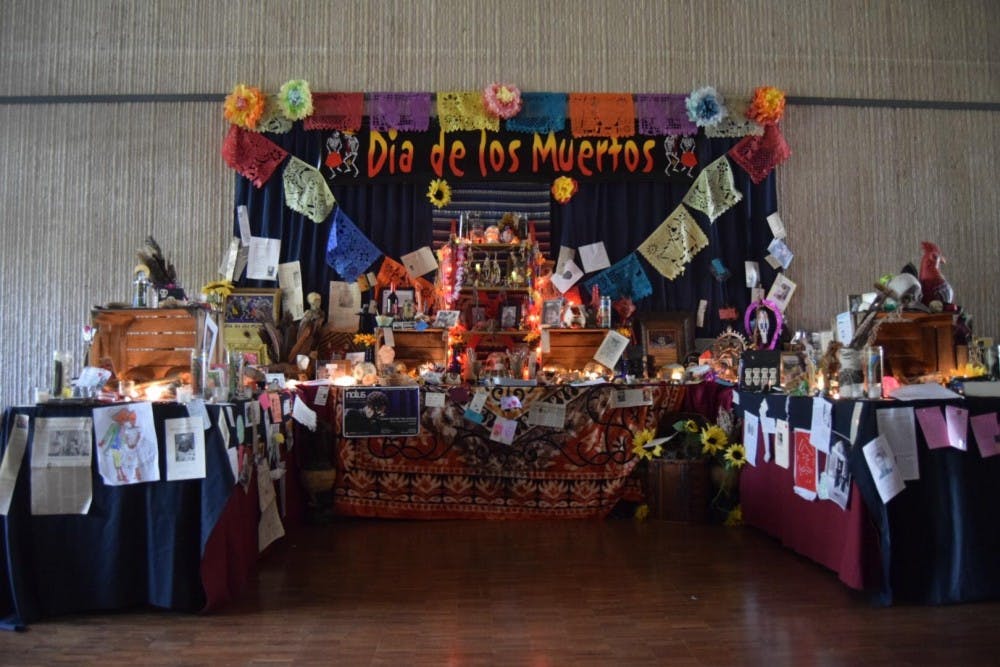The candles on the large table set-up surrounded a myriad of seemingly unrelated items: a box of crayons, a wooden rooster, small bottles of tequila, newspaper clippings and drawings. These were just a few of the offerings community members have left for loved ones through the years for the Día de los Muertos altar lighting.
The annual Day of the Dead Altar closing ceremony, which took place Tuesday at the Mathers Museum of World Cultures, signifies the final day of the altar’s month-long presence at the museum.
After Tuesday, coordinators Rachel DiGregorio and Michael Redman box up the offerings and preserve the messages left for family, friends and public figures who have died. DiGregorio has a box of Jell-O at the altar as a representation of her dead loved one.
“One of the highlights is seeing people come back and see things that they’ve left in the past and realizing that we really do keep everything,” DiGregorio said. “I was just talking to someone a little while ago who said, ‘Oh, there’s my green tea bags I left last year.’”
DiGregorio said Redman scans the notes left by members of the community and places them in a binder at the center of the altar each year for attendees in future years to see all in one place.
Some of the unsigned notes were short, with pithy messages such as “always in my heart” or “love never ends.” Some were written by adults, others by children “Love you Dad, no matter what to me your (sic) still not dead.”
Some people leave photos of loved ones as well. Sarah Hatcher, head of programs and education for the museum, said she remembers one year she was touched by a photographic connection.
“I was giving a tour one year, and a little boy pointed to a photo on the altar and said, ‘That’s my brother,’” Hatcher said.
Christine Marie Evangelista, a member of the community, said she has left several items on the altar in the past six or seven years. The most recent was last year for a young friend of her son.
“It’s a remembrance and an honoring of their lives and what their lives meant to us who remain here,” Evangelista said. “It was always beautiful, but there is definitely a change, the amount of offerings on the altar and how many people consider it a loving thing to do.”
In terms of the various items on display, DiGregorio said her offering of a box of Jell-O has meaning for the person she left it for, as do many of the other food and non-food items left each year.
“It’s amazing to see other people who see an offering and know who it’s left for — that’s sometimes really moving, too,” DiGregorio said. “One of my favorite things, unexplained, is the jar of capers. Who knows why that means something to the person who left that or the person they’re leaving that for?”
The quantity of the different offerings has grown through the years, as has the perspective that seems to be represented by the items and those leaving them, Evangelista said.
“What I noticed this time is there’s a certain kind of humor in some of these things, which is kind of nice to see because traditionally it is a serious ritual,” Evangelista said. “There needs to be a levity with it. It needs to be not about the people being dead but going on a further journey.”
The connection to humanity is something DiGregorio said really stands out to her during each Day of the Dead altar at the museum.
“The one thing that I think of every time I interact with the altar is that we’re all human and we have one thing in common. We’re born, and we die,” DiGregorio said.
The event invites participants to contribute to a larger community project and share in a memorable experience in a way they may not realize, Evangelista said.
“It’s interesting that probably 99 percent of the people who have things on the altar I don’t know,” Evangelista said. “Yet we’ve all come together in some way to pay our respects. That’s so inclusive — we’re all connected in some way, even if we will never know how.”




